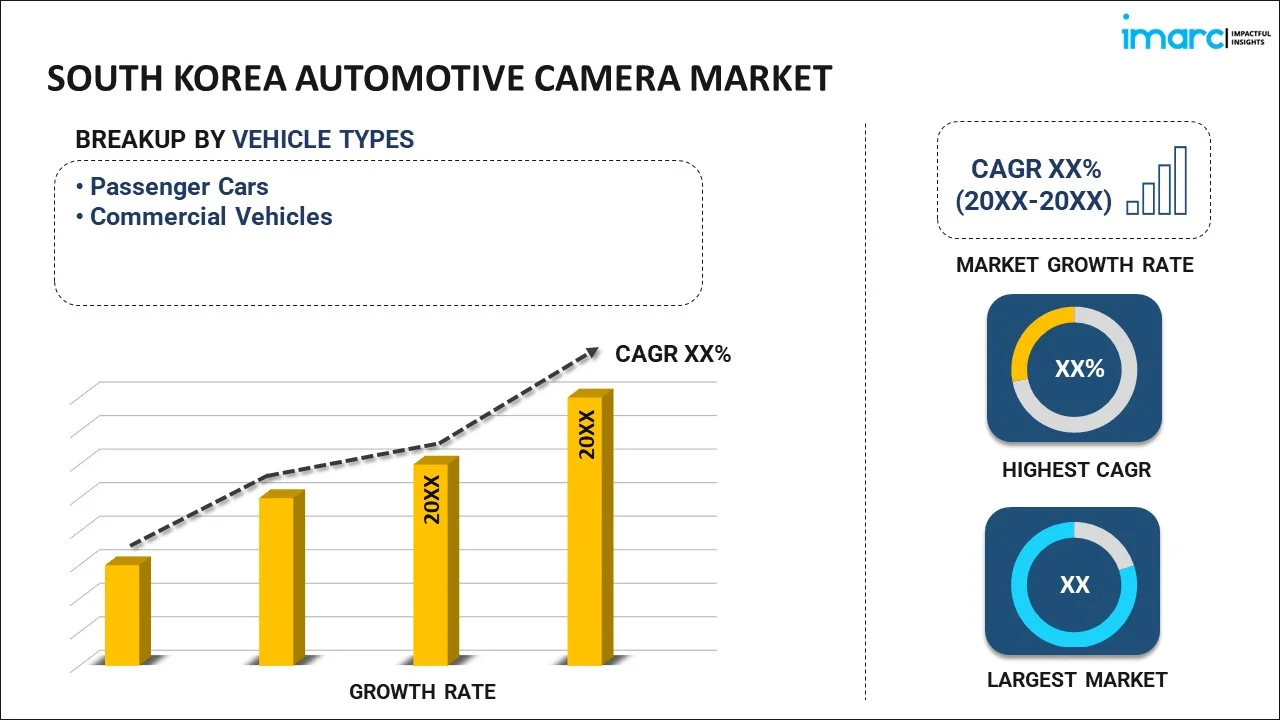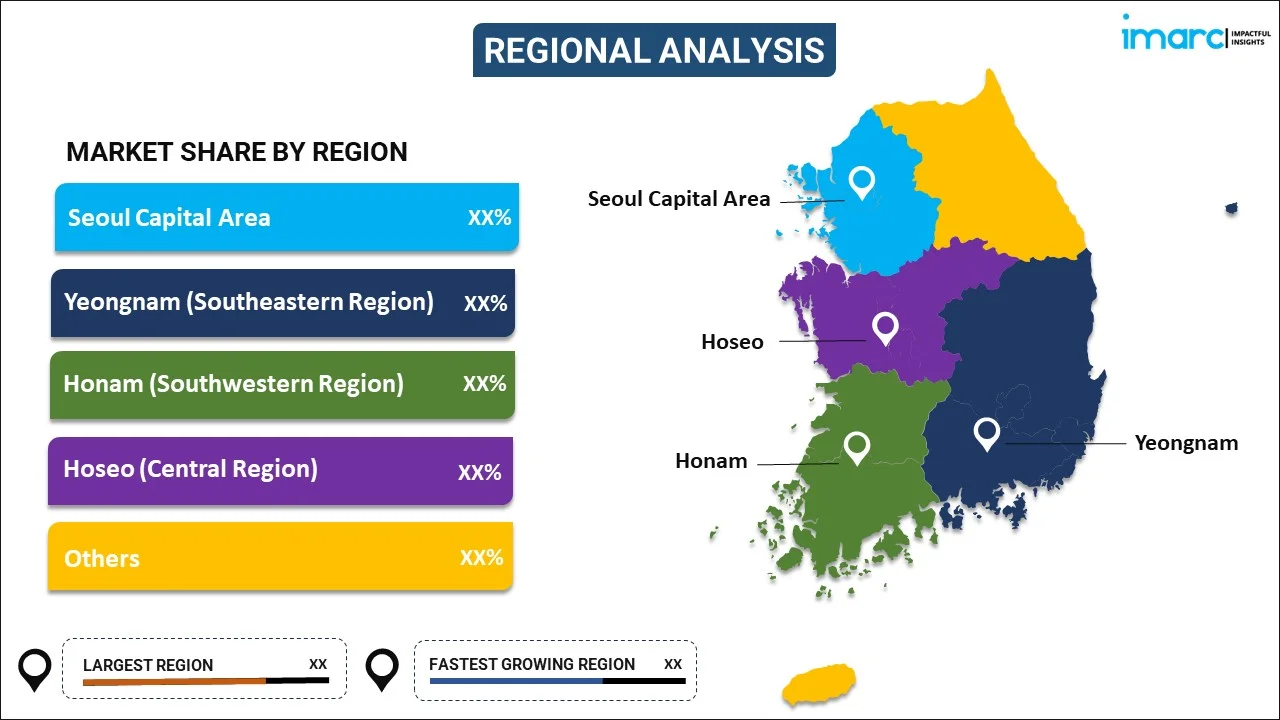
South Korea Automotive Camera Market Report by Vehicle Type (Passenger Cars, Commercial Vehicles), Technology (Digital Camera, Infrared, Thermal), Application Type (ADAS, Parking), and Region 2025-2033
Market Overview:
The South Korea automotive camera market size reached USD 160.0 Million in 2024. Looking forward, IMARC Group expects the market to reach USD 430.0 Million by 2033, exhibiting a growth rate (CAGR) of 10.6% during 2025-2033. The widespread adoption of automotive cameras due to the rising safety concern among individuals, the implementation of several government regulations aimed at improving road safety, and the integration of advanced driver assistance systems (ADAS) that rely heavily on automotive cameras represent some of the key factors driving the market.
|
Report Attribute
|
Key Statistics
|
|---|---|
|
Base Year
|
2024 |
|
Forecast Years
|
2025-2033
|
|
Historical Years
|
2019-2024
|
| Market Size in 2024 | USD 160.0 Million |
| Market Forecast in 2033 | USD 430.0 Million |
| Market Growth Rate (2025-2033) | 10.6% |
An automotive camera is a specialized imaging device developed for use in vehicles, primarily automobiles, to enhance safety, convenience, and driving experience. These cameras are essential in modern automotive technology, contributing to numerous functions within a vehicle. They are commonly integrated into the vehicle's overall advanced driver assistance systems (ADAS). They are available in various types, each serving a distinct purpose. Some commonly known types of automotive cameras include rearview, side-view, front-view, and 360-degree cameras. For instance, rearview cameras are often mounted on the rear of the vehicle, providing drivers with a clear view of the area behind the car when reversing and helping prevent accidents by reducing blind spots and improving parking accuracy. Additionally, side view cameras are placed on the sides of the vehicle, aiding drivers in lane changes and parking that are valuable for larger vehicles, including SUVs and trucks. Also, front-view cameras are positioned at the front of the car, assist in parking and navigating tight spaces, and support ADAS features, including adaptive cruise control. Moreover, 360-degree camera systems combine several cameras to create a panoramic view of the vehicle, making parking and low-speed maneuvering safer and more convenient.
South Korea Automotive Camera Market Trends:
The market is primarily driven by the growing safety concern among individuals. In addition, the rising demand for automotive cameras enhances safety by providing drivers with a clearer view of their surroundings, which is important in densely populated urban areas and on highways, where accidents can have severe consequences, influencing market growth. Moreover, the implementation of several government regulations aimed at improving road safety, which often mandate the installation of certain safety features, including automotive cameras in vehicles, represents another major growth-inducing factor. Manufacturers are compelled to comply with these regulations, which is driving the market growth. Besides this, several technological advancements led to the development of high-definition cameras, night vision capabilities, and advanced sensor technologies that have become standard features in modern vehicles, accelerating the market growth. Along with this, the integration of advanced driver assistance systems (ADAS) that rely heavily on automotive cameras to provide functions such as lane-keeping assistance, adaptive cruise control, and automatic emergency braking are propelling the market growth. Apart from this, the growing automotive industry, including Hyundai and Kia, are expanding their presence and incorporating the latest technologies into their vehicles, including advanced camera systems, contributing to the market growth. Furthermore, some insurance companies are offering reduced premiums to drivers who have automotive cameras installed in their vehicles, which is encouraging individuals to invest in these devices, further creating a positive market outlook.
South Korea Automotive Camera Market Segmentation:
IMARC Group provides an analysis of the key trends in each segment of the market, along with forecasts at the country level for 2025-2033. Our report has categorized the market based on vehicle type, technology, and application type.
Vehicle Type Insights:

- Passenger Cars
- Commercial Vehicles
The report has provided a detailed breakup and analysis of the market based on the vehicle type. This includes passenger cars and commercial vehicles.
Technology Insights:
- Digital Camera
- Infrared
- Thermal
A detailed breakup and analysis of the market based on the technology have also been provided in the report. This includes digital camera, infrared and thermal.
Application Type Insights:
- ADAS
- Parking
The report has provided a detailed breakup and analysis of the market based on the application type. This includes ADAS and parking.
Regional Insights:

- Seoul Capital Area
- Yeongnam (Southeastern Region)
- Honam (Southwestern Region)
- Hoseo (Central Region)
- Others
The report has also provided a comprehensive analysis of all the major regional markets, which include Seoul Capital Area, Yeongnam (Southeastern Region), Honam (Southwestern Region), Hoseo (Central Region), and Others.
Competitive Landscape:
The market research report has also provided a comprehensive analysis of the competitive landscape in the market. Competitive analysis such as market structure, key player positioning, top winning strategies, competitive dashboard, and company evaluation quadrant has been covered in the report. Also, detailed profiles of all major companies have been provided.
South Korea Automotive Camera Market Report Coverage:
| Report Features | Details |
|---|---|
| Base Year of the Analysis | 2024 |
| Historical Period | 2019-2024 |
| Forecast Period | 2025-2033 |
| Units | Million USD |
| Scope of the Report | Exploration of Historical Trends and Market Outlook, Industry Catalysts and Challenges, Segment-Wise Historical and Future Market Assessment:
|
| Vehicle Types Covered | Passenger Cars, Commercial Vehicles |
| Technologies Covered | Digital Camera, Infrared, Thermal |
| Application Types Covered | ADAS, Parking |
| Regions Covered | Seoul Capital Area, Yeongnam (Southeastern Region), Honam (Southwestern Region), Hoseo (Central Region), Others |
| Customization Scope | 10% Free Customization |
| Post-Sale Analyst Support | 10-12 Weeks |
| Delivery Format | PDF and Excel through Email (We can also provide the editable version of the report in PPT/Word format on special request) |
Key Questions Answered in This Report:
- How has the South Korea automotive camera market performed so far and how will it perform in the coming years?
- What has been the impact of COVID-19 on the South Korea automotive camera market?
- What is the breakup of the South Korea automotive camera market on the basis of vehicle type?
- What is the breakup of the South Korea automotive camera market on the basis of technology?
- What is the breakup of the South Korea automotive camera market on the basis of application type?
- What are the various stages in the value chain of the South Korea automotive camera market?
- What are the key driving factors and challenges in the South Korea automotive camera?
- What is the structure of the South Korea automotive camera market and who are the key players?
- What is the degree of competition in the South Korea automotive camera market?
Key Benefits for Stakeholders:
- IMARC’s industry report offers a comprehensive quantitative analysis of various market segments, historical and current market trends, market forecasts, and dynamics of the South Korea automotive camera market from 2019-2033.
- The research report provides the latest information on the market drivers, challenges, and opportunities in the South Korea automotive camera market.
- Porter's five forces analysis assist stakeholders in assessing the impact of new entrants, competitive rivalry, supplier power, buyer power, and the threat of substitution. It helps stakeholders to analyze the level of competition within the South Korea automotive camera industry and its attractiveness.
- Competitive landscape allows stakeholders to understand their competitive environment and provides an insight into the current positions of key players in the market.
Need more help?
- Speak to our experienced analysts for insights on the current market scenarios.
- Include additional segments and countries to customize the report as per your requirement.
- Gain an unparalleled competitive advantage in your domain by understanding how to utilize the report and positively impacting your operations and revenue.
- For further assistance, please connect with our analysts.
 Request Customization
Request Customization
 Speak to an Analyst
Speak to an Analyst
 Request Brochure
Request Brochure
 Inquire Before Buying
Inquire Before Buying




.webp)




.webp)












